Contrast
WARNING: Do not cite this page as a reference. This page is on this wikispace only to make the content "searchable" and easier to find. If you find the information you seek here, go to the original sources as linked below to verify the information and use them for your documentation.
Glossary of Terms:[edit | edit source]
A level of visual distinction between different tinctures. The Rules for Submissions Part VIII, Section 2.a. define good contrast. [Replaced by SENA [[1]]
Zero Contrast Charges:[edit | edit source]
Link to the original Spreadsheet on Google Docs - Spreadsheet
Form to add new examples to the Tincture IAP Spreadsheet - Form
1506-1509 Livro do Armeiro-Mor (Livre du Grand Armurier) http://www.vikinganswerlady.com/FTP_Files/1506-1509_Livro_do_Armeiro-Mor_Portugal.pdf
- Dom Pêro Rodrigues Protonotário (111v): Gules, a demi-lion crowned Or maintaining a sword proper and on a chief gules a two-headed eagle Or
| Insignia | 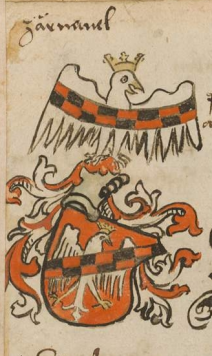
|
| Insignia Anglica, BSB 291, f28v, argent fretty gules and overall a cross argent. | Familienwappen des Hohen Adels, 14v2, a bend sinister overall checky gules and sable on a gules field |
Dictionary of British Arms; Medieval Ordinary, Volume three, page 202, under "Patterned field 1 plain cross plain border" is Arg fretty Gu cross Arg border Sa, for one Sir Hew Bryce, from WK (which is Writhe's Book of Knights, temp. Henry VII)
| Livro |
| Armas | 16th | BSB |
Partially Zero-contrast Partitions/Divisions[edit | edit source]
Found by Iago ab Adam:
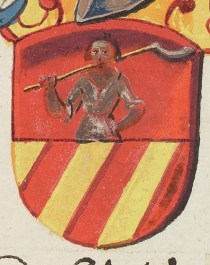
|
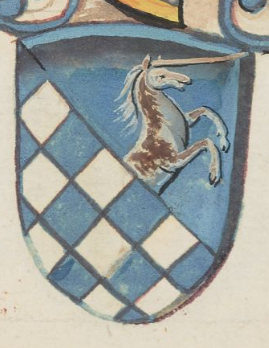
|
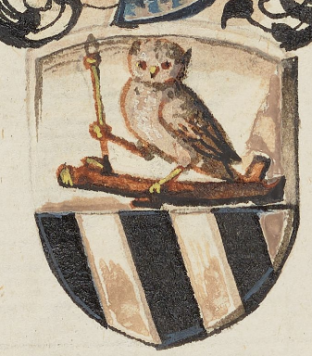
|
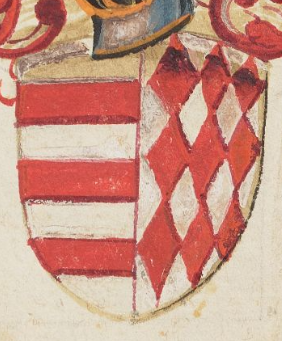
|
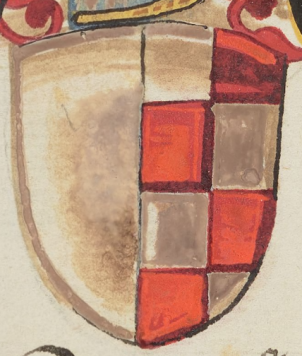
|
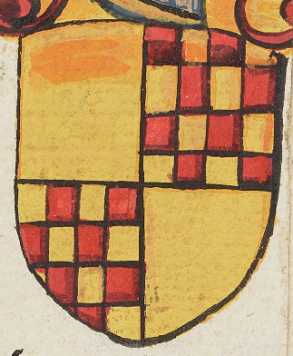
|
Found by Lillia de Vaux:
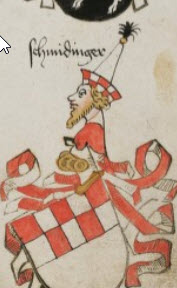
|
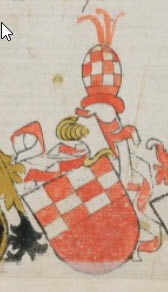
|
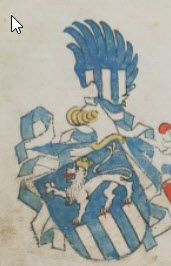
|
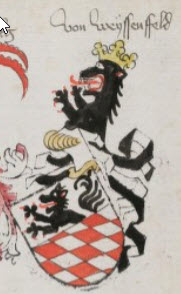
|
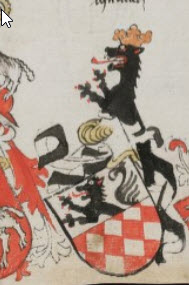
|
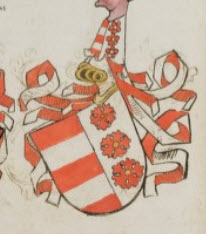
|
See also "A Collation of Laurel Precedents Regarding Contrast and Complex Lines"
SENA A.3.B.2.:[edit | edit source]
http://heraldry.sca.org/sena.html#A3 2. Definition of Good Contrast: Good contrast between two tinctures means that they are not from the same classification. Pairings such as a color and a color or a metal and a metal are said to have poor contrast or to be low contrast. Pairings of the same tincture are said to have no contrast, and are allowed only as artistic details. The following pairings are said to have good contrast:
- a color and a metal
- a color and a neutral tincture
- a metal and a neutral tincture
In some cases, two neutral tinctures may have good contrast with each other, but identifiability must be maintained. This occurs most often when a charge is counterchanged over a line of division. In such a case, both the field and the charge are, as a whole, classified as neutral, but all edges that touch have good contrast with each other. [Updated 7 July 2013]
From Assorted Lessons in SCA Heraldry[edit | edit source]
http://heraldry.sca.org/laurel/lessons/lesson19.html
SCA Armory is expected to exhibit good contrast between charges and the ground upon which they lie. This lesson will discuss armorial contrast.
The Rules for Submissions defines good contrast in terms of colors, metals, and combinations of the two.
To review:
- Colors are "dark", and are Sable, Gules, Vert, Azure, and Purpure.
- Metals are "light", and are Or and Argent.
- Neutral is evenly composed of "light" and "dark".
In a sense, it is a black, white, and gray issue.
SCA heraldic practice treats furs differently from mundane heraldic practice. Ermine and its variations are treated for contrast as if the spots were not present. That is, ermine is functionally Argent, while Pean is functionally Sable. Vair and other furs that are evenly divided are treated as neutral.
There is good contrast between a light tincture and a dark tincture. There is usually good contrast between a neutral tincture and a light or dark tincture. If a field or object is being divided in two parts, quarterly, or per saltire, there may be low contrast between the parts, that is, two metals or two colors. However, if the line of division is bumpity (non-straight), some combinations of tinctures have such low contrast as to be unusable. Consider, "Per fess wavy sable and purpure". Officially, there is low contrast between the tinctures. In fact, the contrast is so low that the nature of the bumpity line is almost impossible to see under reasonable viewing conditions. For this reason, this combination is unusable with a bumpity line.
On the other hand, "Per bend indented gules and sable" has sufficient contrast to allow an observer to see the nature of the bumpity line.
Neutral tinctures seem to cause the most confusion with contrast. The rules allow any combination of a neutral tincture and a color or metal, as long as the charge remains identifiable.
For example, "a lion rampant barry azure and argent" has a neutral tincture. This particular charge could be placed on most any field. However, consider an azure field or an argent field. Now, half of the lion is the same tincture as the field. This renders the lion unidentifiable. In addition, this charge would be unidentifiable on any divided field containing azure or argent.
As another example, consider "a bordure compony gules and Or." This bordure has a neutral tincture but is unusable on an Or or gules field.
Note in both examples that the problems crop up when the neutral tincture shares a tincture with the color or metal. As a rule of thumb, a neutral tincture will not have sufficient contrast with either of its component tinctures.
Of course, there are exceptions.
The term compony is used to describe a long ordinary or similar object that is divided into blocks that alternate between two tinctures.
Counter-compony means that there are two rows of blocks, while checky means at least three rows.
Bordures counter-compony and checky, and ordinaries checky remain identifiable even when one of their tinctures is that of the field.
In some circumstances there is not enough contrast, even when the charge is neither of the tinctures of the neutral field.
For example, in "Quarterly azure and argent, a lion rampant sable", the black lion lies mostly on the blue quarters. This makes it difficult to see. If you reverse the tinctures of the field, the black lion now lies mostly on the white quarters, making it much more identifiable.
In "Per chevron Or and sable, a tree eradicated proper.", the roots of the tree, being brown, are hard to make out against the black portion of the field. Reversing the tinctures of the field puts the brown roots against the gold portion of the field, while the green parts have adequate contrast against the black parts.
Per bend indented gules and sable. 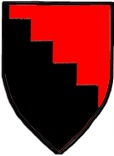
|
Per fess wavy sable and purpure 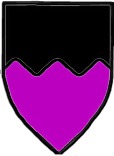
|
a lion rampant barry azure and argent 
|
a bordure compony gules and Or 
|
Quarterly azure and argent, a lion rampant sable 
|
Per chevron Or and sable, a tree eradicated proper 
|
Precedents:[edit | edit source]
Precedents of the SCA College of Arms - http://heraldry.sca.org/laurel/precedents.html
Morsulus Heralds Website - http://www.morsulus.org/ (to search the LoARs and Precedents)
Restatement Wiki - http://yehudaheraldry.com/restatement/index.php?title=Main_Page (restatements of Precedents)
Use the above links to be sure any precedents listed below haven't been superseded by newer precedents.
Collected Precedents:[edit | edit source]
- 2nd Tenure of Elisabeth de Rossignol (April 2011 - August 2011) - Collected Armory Precedents
- 1st Tenure of Elisabeth de Rossignol (May 2005 - July 2008) - CONTRAST
- 2nd Tenure of François la Flamme (October 2004 - May 2005) - CONTRAST
- The Tenure of Shauna of Carrick Point (May 2004 - August 2004) - Collected Armory Precedents
- 1st Tenure of François la Flamme (August 2001 - April 2004) - Collected Armory Precedents
- The Tenure of Elsbeth Anne Roth (June 1999 - July 2001) - Collected Armory Precedents
- The Tenure of Jaelle of Armida (June 1996 - June 1999) - Single HTML Document
- 2nd Tenure of Da'ud ibn Auda (November 1993 - June 1996) -
- The Tenure of Bruce Draconarius of Mistholme (June 1992 - October 1993) - Collected precedents
- 1st Tenure of Da'ud ibn Auda (June 1990 - June 1992) -
- The Tenure of Alisoun MacCoul of Elphane (September 1986 - June 1990) - Collected Precedents
- The Tenure of Baldwin of Erebor (August 1984 - August 1986) - Single HTML Document
- The Tenure of Wilhelm von Schlüssel (August 1979 - August 1984) - Collected Precedents
- The Tenure of Karina of the Far West (December 1975 - June 1979) - Collected Precedents
- The Early Days (June 1971 - June 1975) - Collected Precedents